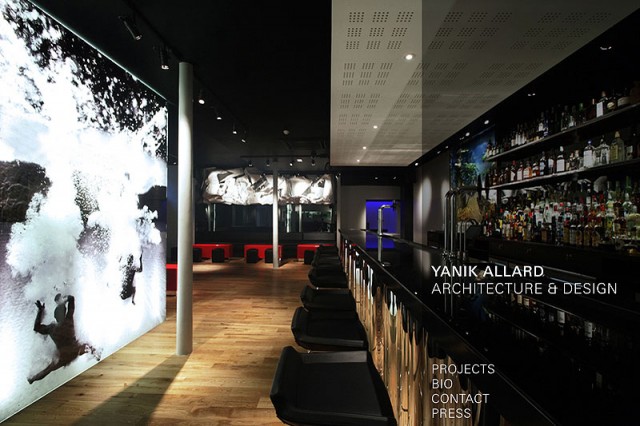Yanik Allard
/in Portfolio /by krzysDesign & Web 2.0 As A Fiction
/in web2 /by krzysThe term Web 2.0 is used to describe the forthcoming version of the sites; the world is on the way to modify their websites so that it may be more interactive, simple, nice-looking, eye catching, utilizable and sharable by designing it with web 2.0 technologies. Web 2.0 is not only improving the concept of web design but also giving a new trend to the web marketing, programming and the usability concepts.
Design
The idea of Web 2.0 also have its reflection in the design. Following are the prominent design consideration:
Round Corners: It gives a new style to the corners and makes it rounded in buttons or in the contents boxes.
Simplicity: Web 2.0 preferred the design to be simple, with less volume of contents, more images and relatively large fonts.
Centralized Contents: Preferably contents of the website page are in the middle of the page and the right and left space are to be filled with background of gradient colors.
Navigation: The horizontal navigation is the mostly suggested style in web 2.0. Navigation should be very clear and fonts size should be large fonts.
Backgrounds: There are a number of backgrounds used in Web 2.0. They may either to be gradient colors or diagonal line pattern.
Reflection: In general the perception of appearance in the Web 2.0 is to make some reflection on your images.
Light box: To show large version of a graphic, large map, warning message box and other such applications, light box is used in Web 2.0
Ajax: Ajax features in Web 2.0 makes the website more eye-catching, usable and fast.
Web 2.0 as a fiction
The term Web 2.0 is used to portray a tendency in web design that emphasis creativity, sharing of information and interaction of users in the form of user contributed content. This term is frequently utilized to publicize as a stylish word, or for exaggeration of the actual expense of the project and the promotion of self-worth before the clients.
This term means very different things for different people. Consequently, this term is very skeptical in the company professionals, because it is hard to find basic distinction from the standard Web 2.0 websites.
Ajax, Tags, Mash-up and Web syndication
/in web2 /by krzysAjax
Ajax is abbreviation for Asynchronous JavaScript and XML. AJAX is used to construct interactive web applications by means of a group of interconnected web development methods used on the client-side. In such applications, web page asynchronously loads the appropriate user data without reloading. Asynchronous JavaScript and XML is actually not a new programming language or technique, but in fact it is a modern way to use existing standards. Ajax is widely used in Web 2.0. When Google started actively use of Ajax in the creation of their sites like Gmail and Google Maps, the popularity of Ajax increased to the great extent. A lot of people often considered synonymous with the Ajax Web 2.0, but as the matter of fact, it is not the fact. The possibility of asynchronous refresh the page was already provided by Flash.
Web syndication
It is a mode of syndication in which information or website material including audio-and video-on different pages or web sites is made available to multiple other websites. This distribution of information is done simultaneously. Most commonly, web syndication refers to making use of technology RSS or Atom. Initially, web syndication was utilized for blogs and news sources, but its scope has been expanded with the passage of time. The term “Web syndication” is also used to express other kinds of licensing content of website so that other websites can make us of these information.
Mash-up
The term mash-up is a new sort of web-based applications in which two or more different services are mixed up from unrelated and even competing web sites. This service is used (completely or partially) as sources of information, providing users with new functionality to work. In consequence of such a service may also become a new source of information for other web mash-up services. Hence a network is formed of interrelated services that are integrated with each other.
Tags (tags)
Key words telling the object in question, or linking it to any category is called tags. These sorts of labels are allocated to the object to ascertain its place among other objects. The concept of labels is strongly related to the concept of folksonomy. Folksonomy is a term which is extensively discussed it in relation with the development of Web 2.0 services like Wink, Flickr, etc
How Web 2.0 Functions
/in web2 /by krzysThe term “Web 2.0” is closely associated with Tim O’Reilly. It is a method associated with web applications. Web 2.0 facilitates designing interactive systems for information sharing, interoperability and collaboration on the WWW (World Wide Web). Social-networking sites, forums, blogs, video-sharing sites, wikis and RSS are examples of Web 2.0 These sites allow its users to intermingle with other users of the sites and even may change the contents of websites.
Though the term “Web 2.0” indicate a latest new version of the WWW (World Wide Web) but in fact this term does not refer to updating of any technical specifications. It only cumulative changes in the ways end-users and software developers use the net.
The phrase Web 2.0 is not a scientific term:
The term “Web 2.0” firstly used Mr. Tim O’ Reilly in his article “What Is Web 2.0”. This article was published on 30 September 2005 in the journal Computerra. In this article, Tim O’Reilly, related the emergence of a huge number of sites, combined by several broad principles, with the common trend of emergence of the Cyber community, and named it the Web 2.0 phenomenon. The meaning of this term is much debatable. But some scholars, who accept the existence of Web 2.0, allot some fundamental aspects of this phenomenon.
Following technologies are used in the development of Web 2.0:
- Asynchronous JavaScript and XML (Ajax)
- Adobe Flash
- Adobe Flex framework
- JavaScript/Ajax frameworks like Yahoo! UI Library, MooTools, Dojo Toolkit and jQuery.
For uploading and downloading new data from the web server without undergoing a full page reload, Ajax programming uses JavaScript.
Communications like data requests going to the server are separated from data returning to the page (asynchronously) in order to allow the user to keep on interacting with the page. If it is not done, the user would have to consistently wait for the data to come back before they can work on that website page (just as a page reload). This method of communication improves the performance of the website as well.
Another technology often used in Web 2.0 applications is Adobe Flex. Web 2.0 also uses technologies like PHP, Ruby, ColdFusion, Perl, Python, ASP on the server side.
cPanel hosting features:
Additional Pages
Blogroll
Address
Notthing Hill Gate
W11 2AF, London
Phone: 0207 183 5170
Email: info@webandseo.co.uk
Recent Posts
- Web Design Suggestions To Increase Your Visitor Engagement
- A Guide to Dealing with Negative Search Results
- Why Internal linking Is Good for SEO?
- 10 WAYS DESIGNERS CAN ATTRACT DEVELOPERS
- Do You Feel There Is More To Learn About Search Engine Optimization?
- The Effect Of Social Signals on SEO
- DISHONORED 2
- Creative Web Design: Color Scheme, UI Animations
- Do you require help acquiring visitors to your website?
- The Perks of Online Video Distribution – Harness the Full Power of Your Explainer Videos
- Using Movavi Screen Capture Studio to Record a Web Design Video
- You May Style A Web Site With This Particular Assistance
- 7 Best Possible Ways to Kick Start SEO
- Niteskape: Web Design & SEO. Where is the Golden Ticket?
- Professional Web Design: What You Need To Know






